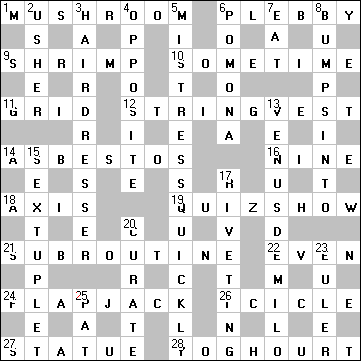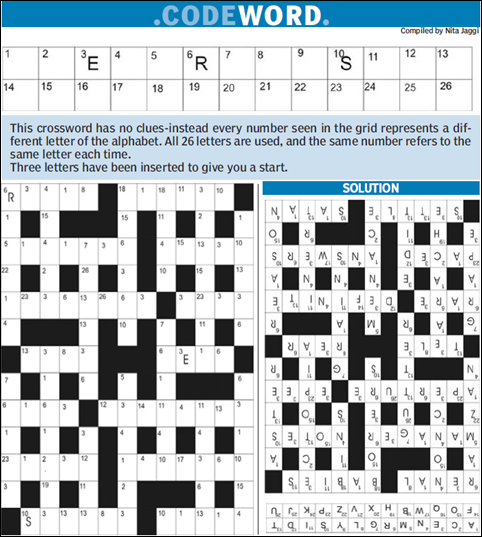This is the fourth instalment in a series of posts about crossword grids. Previous entries in the series: grid symmetry, checking, connectivity.
The term "pangram" is generally used for a sentence that contains each letter of the English alphabet. "The quick brown fox jumps over the lazy dog" is a well-known example.
In cryptic crosswords, a "pangram" is a grid that has at least one occurrence of each letter of the English alphabet.
Here's an example of a pangrammatic grid:

Grid for Financial Times 12797 (Monk)
Pangrams and Solvability
A pangrammatic grid does not usually announce itself [1]. It's an unassuming grid property that the solver, unless alert, can easily miss noticing.
If you find a few unusual letters like Q, Z and J in the grid, it may be a hint that a pangram is on the way. This knowledge could help you fill up faster, as you'd look for the missing letters to cover the alphabet.
The strategy can easily backfire though. It's entirely possible that the grid is an X-lipogram and you've gone on a wild-goose chase looking for a missing X.
The best thing to do is to keep an eye on the letters, but not rely too much on finding a pangram.
Nita Jaggi's so-called pangrams
[1] A pangrammatic grid does not usually announce itself – Exceptions exist, such as the crossword called CODEWORD composed by Nita Jaggi in the paper DNA. This puzzle states openly that it uses each letter of the alphabet. It is another matter that even after this proclamation, many letters are regularly found missing from the grid. Look at this supposedly pangrammatic grid published in DNA on 10th September 09, which has at least a missing J and K:
Thanks to Col. Gopinath for sharing this, as well as a rare triple pangram from the NY Times crossword – here.
Related Posts:
If you wish to keep track of further articles on Crossword Unclued, you can subscribe to it in a reader via RSS Feed. You can also subscribe by email and have articles delivered to your inbox, or follow me on twitter to get notified of new links.







7 comments
Thanks, did not know of this meaning of 'pangram' wrt crosswords.
"many letters are regularly found missing". Hah.
@Subs: Glad you noticed the "regularly", I was hoping someone would :)
Ah Pangram is it?
I've tried my hand at this without any knowledge of what it was called.
Section 3 (Alphabet Soup) of this doc has an attempt at this.
Though the intro to Codeword says that all 26 letters are used, this grid, as noted by you, is not a pangram.
The grid has 53 blackouts (31.4 per cent).
Total Across words - 14
Total Down words - 14
Words ending in S - 6
Average word length - 5
It has 116 letters.
Unused letters are J K Q V X and Y
Letters used:
A - 18 B - 2 C- 4 D - 2
E - 22 F - 1 G - 3 H - 1
I - 6 J - 0 K - 0 L - 3
M - 2 N - 10 O - 5 P - 3
Q - 0 R - 13 S - 8 T - 9
U - 2 V - 0 W - 1 X - 0 Y - 0
Z - 1
Thanks for the detailed breakdown, CV Sir. 6 unused letters in a grid that claims to be a pangram is inexcusable. Apparently this isn't a one-off error either, DNA's Codeword has had letters missing in the past too. Sloppy compiling at its worst.
Wonderful! I've known what a pangram is, but I must confess I haven't been one of those alert solvers. Time to 'alter' that ;)
Very fascinating, this post and the series you're doing in general.
1 Jan 2018 The Independent had this pentapangram http://www.fifteensquared.net/2018/01/01/independent-9740-maize/
Post a Comment